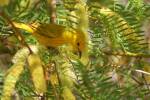Banding project helps track bird populations
The 2013 waterfowl season got off to a good start with local hunters bagging limits of resident birds and some early migrants, but the action slowed quickly as those birds moved out and balmy temperatures lingered over Southern Nevada. This has waterfowl hunters hoping that a weather front will come in from the northwest and begin pushing a few ducks and geese our way.
According to the National Weather Service forecast, they might get their wish. Winter storms are expected to arrive in Elko County and northern Utah late this week and should move birds south from the Ruby Marshes, Bear River National Wildlife Refuge and the Great Salt Lake area. Hunters planning a trip to the Kirch Wildlife Management Area — Sunnyside to old-timers — should go prepared for all weather possibilities. Nighttime temperatures in the low to mid-20s could result in skim ice in the early morning.
Early this week, I spoke with two hunters who already have bagged a couple of banded ducks this season. For those who might be new to waterfowl hunting, a banded bird is one that has been fitted with a metal leg band. On that band is a unique number, similar to a serial number, which identifies the bird. In addition, you will find a phone number (800-327-BAND) and website address (www.reportband.gov) for reporting purposes.
Every year, biologists from the United States and Canada band more than 200,000 ducks and about 150,000 geese and swans, according to the folks at www.Flyways.US. This is a collaborative effort with the U.S. Fish and Wildlife Service and other waterfowl managers across North America. Though the first large-scale banding project began in 1922, it was not until 1946 that scientists organized an international banding effort. By banding birds and giving them individual identification numbers, biologists have been able to compile data on movement, life span, survival rates, sports harvest and the effect of regulations on bird populations.
One of the first things biologists were able to do with the data gathered through the banding program is identify the four major flyways in North America. Flyways are travel corridors waterfowl use to migrate south from their breeding grounds in Alaska and Canada. They are designated as the Atlantic, Mississippi, Central and Pacific flyways. Nevada is included in the Pacific, along with the other Western states.
Biologists also learned that some birds use one flyway when migrating south and another on their way north. Data collected through banding also is used during the season setting process, so it is important that data reported is done so accurately.
Though it is not required by law, hunters who harvest birds wearing bands are encouraged to report their harvest. This can be done by calling the toll-free number on the band or online. Be prepared to provide the date and location of where the bird was taken. Hunters who report their harvest are welcome to keep the band and will receive a certificate with information about the bird. That information includes gender, age and the location where the bird was banded.
Approximately 85,000 to 90,000 bands are reported each year. In 2012, 478 banded mallards were recovered in Nevada, along with 141 Canada geese, among others. If you want to see how many banded birds of a specific species were found in a specific state, you can do that at Flyways.us.
Did you know the oldest known waterfowl banded in North America was a Canada goose that lived to be 30 years and 4 months old? Or that the oldest mallard lived to 26 years, 4 months? Knowing that won’t make you a better duck hunter, but when your son or daughter asks the question, you will have the answer. And it is based on data collected through the banding project.
Freelance writer Doug Nielsen is a conservation educator for the Nevada Department of Wildlife. His “In the Outdoors” column, published Thursday in the Las Vegas Review-Journal, is not affiliated with or endorsed by the NDOW. Any opinions he states in his column are his own. He can be reached at intheoutdoorslv@gmail.com.























